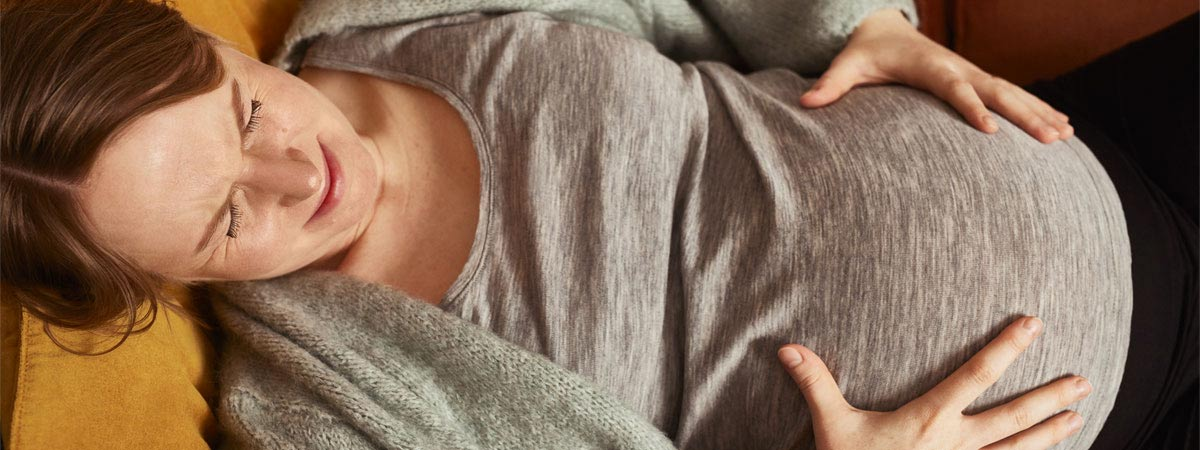Early labour pain, contractions and afterpains
You’ll become acquainted with pains of various kinds during pregnancy. Early labour pain and contractions – but what’s the difference? Here, we present what these are – and what they feel like.
What are Braxton-Hicks contractions and what is early labour pain?
When the uterus begins practicing for childbirth, this large muscle contracts, causing the tummy to become momentarily firm and then soft again. We call these Braxton-Hicks contractions. They happen now and then during pregnancy, sometimes as early as week 20, and are completely normal. But as you get closer to childbirth, the uterus often wants to practice a little extra for the big day – and then we start talking about early labour pain. Early labour pain can pop up for the first time the day before the baby arrives; they can also last for several days before childbirth, and for some people, they might not happen at all.
What does early labour pain feel like?
Just like Braxton-Hicks contractions, early labour pain involves the uterus contracting, and the closer you get to childbirth, the more frequently they occur. Unlike Braxton-Hicks contractions, early labour pain sometimes hurts, especially as it intensifies. It can be similar to menstrual cramps, with a dull ache in the back and tailbone, and might also radiate from the belly down into the groin.
If you have given birth before, you will likely experience early labour pain earlier than first-timers; the muscle memory of the uterus may understand what it was like last time and feels that the body is getting ready for labour. But some people don’t experience early labour pain at all, and the important thing isn’t really to learn to differentiate between Braxton-Hicks and early labour pain, but to monitor when the contractions are starting to become more regular.
Get medical attention if you start to bleed
Braxton-Hicks contractions during pregnancy, which occur in conjunction with physical activity, and the early labour pain that happens as you approach childbirth, are completely normal. But if something feels off or if you have unrelenting early labour pain that is regular and painful, even though you are not close to your due date – then contact your doctor, midwife, or the maternity ward. If the pain becomes more regular or if you simultaneously begin to bleed, you should seek medical attention immediately.
When early labour pain becomes contractions
At first, early labour pain may happen now and then – it could pop up and then stop for a few hours or a day, but with time, this pain becomes increasingly regular and intense. At some point during the latent phase – childbirth consists of several different phases – the pain will become so intense and regular, with short breaks in between, that it is now considered to be contractions. These contractions are stronger and more painful, and it will feel like the pain is coming from your back, belly, groin and vagina, moving down into your thighs. This will feel like a downward pressure and will become increasingly intense.
When you are having about three contractions in ten minutes, it’s time to call the maternity ward to see if you should come in. Keep in mind that you shouldn’t sit and wait for your water to break, because that might not happen until the last minute.
Manage the pain
Giving birth is painful, but what that pain feels like is highly individual – as is how to handle it. At first, during the latent phase when you will usually be at home, it is good to try to relax as much as you can. Heat, massage, and a painkiller with paracetamol usually help. Otherwise, our best tip is to prepare yourself well before childbirth to have a sense of how your body and the pain function.
If contractions don’t come
When it’s time is up to the baby, and some babies are far too content inside the belly. If labour doesn’t begin spontaneously, you may have to be induced.
Afterpains
After you give birth, the uterus will want to contract to become something like its former self. It will start to do so fairly soon after the baby and placenta are out. These are known as afterpains and feel like mega Braxton-Hicks contractions. They tend to be stronger for non-first-timers than for first-time mums. Usually, they are particularly apparent if and when you breastfeed, because the musculature of the uterus is stimulated to contract then. After about 2–3 days, they disappear.
This can often be a little painful, but it’s nothing dangerous – it’s exactly what the body is supposed to do. Many maternity wards offer acupuncture for afterpains, but painkillers can often do the trick. A heated cushion or wheat pillow on your belly can feel nice. It may also be nice to know that you could have some extra bleeding in conjunction with afterpains. If you’re having a lot of bleeding, then talk to the staff at the maternity ward for help.
Please note that all information above is based on Swedish recommendations.


